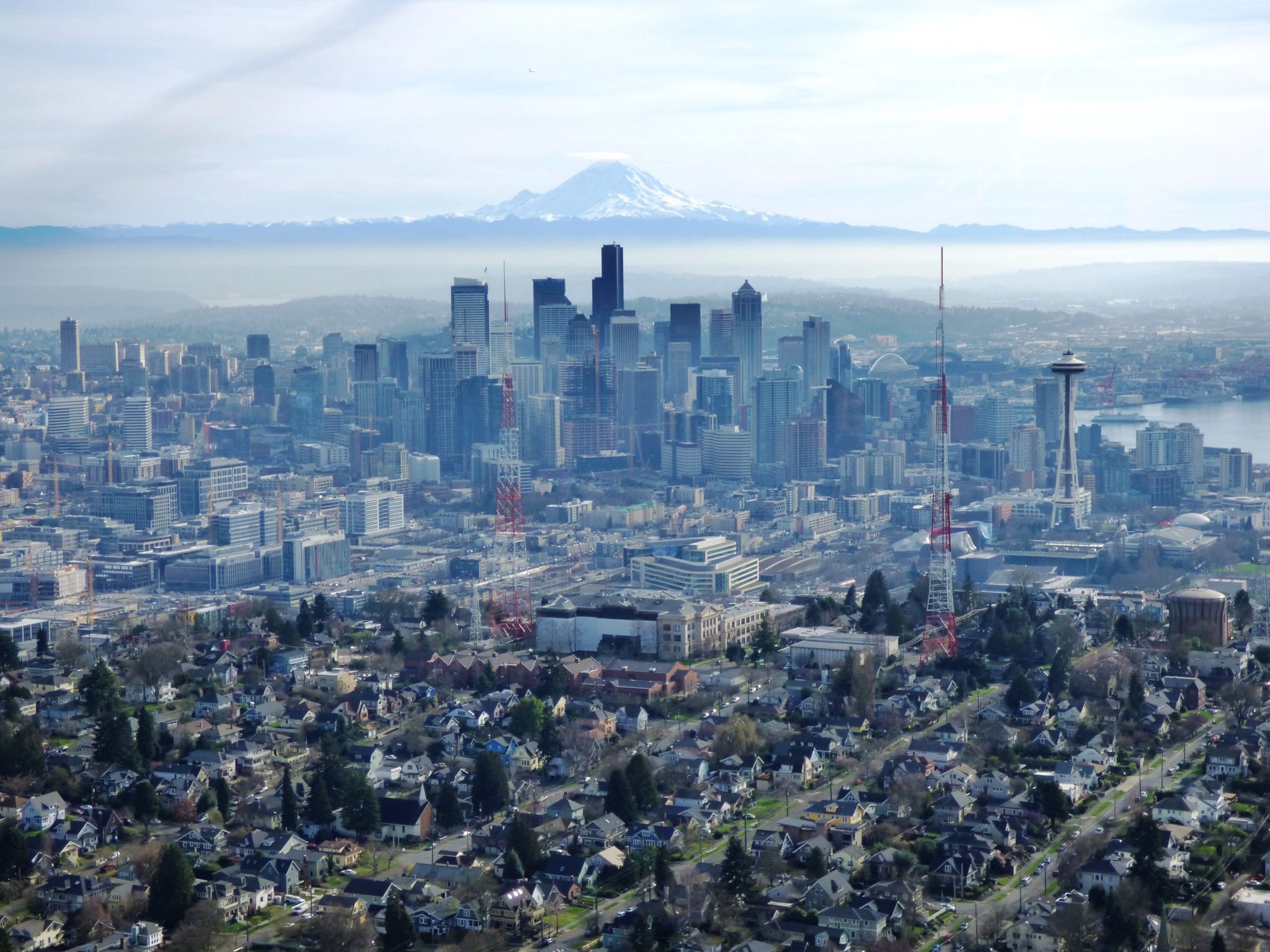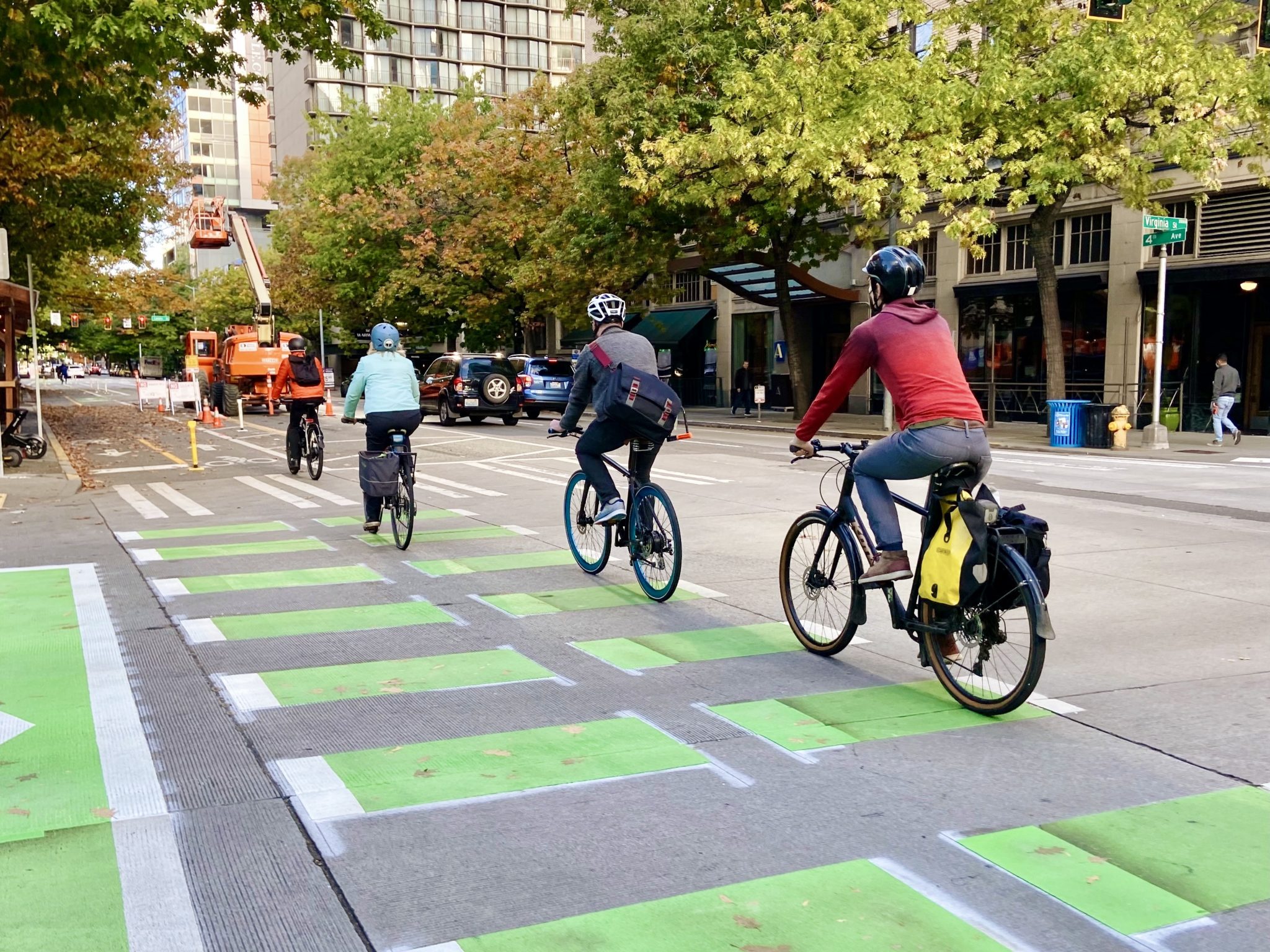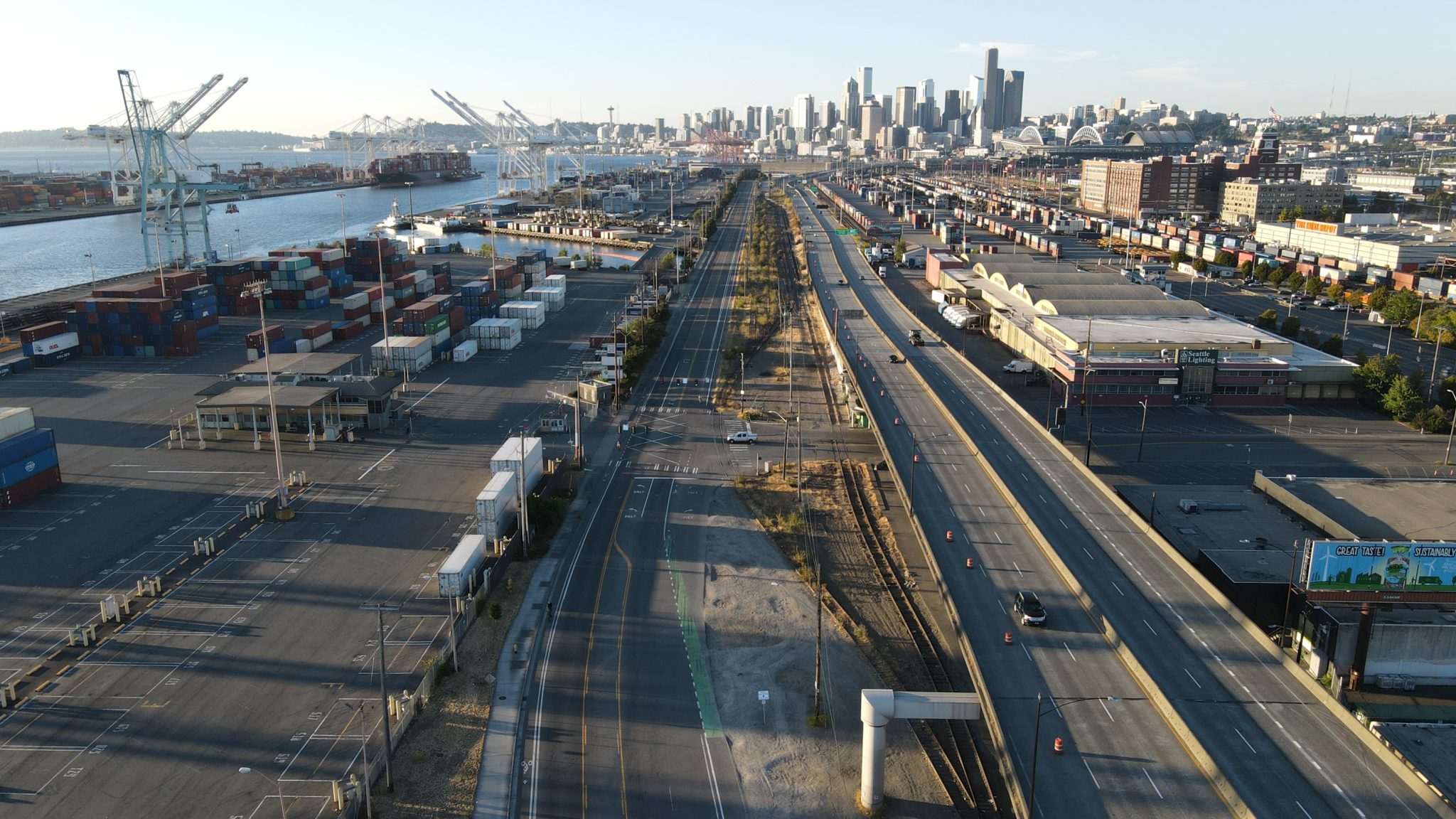 Aerial view of the city of Seattle. Photo credit: Ethan Bancroft & WSDOT.
Aerial view of the city of Seattle. Photo credit: Ethan Bancroft & WSDOT. Editor’s Note (May 3, 2024): We originally published this blog post on March 9, 2022, and have continued to update it since then with the latest information.
Summary:
- The Seattle Department of Transportation (SDOT) has several volunteer opportunities for members of the public to get involved and help shape how transportation works in the city.
- While each board has a specific focus, they all serve as advisors to the Mayor, Seattle City Council, and City departments.
- The six (6) boards and committees described in this blog post rely on volunteer members. These members bring valuable community perspectives as part of promoting a robust, inclusive public dialogue on projects of a variety of sizes.
- Apply via the City Clerk’s website.
- Applications received for boards with no current vacancies will be saved for a year and will be reviewed for any mid-term openings or at the next open recruitment period.
- You can apply to multiple boards at the same time.
- Applications are currently open for the following:
- School Traffic Safety Committee (STSC) – Applications are being reviewed on a rolling basis.
Below you can find ‘drop-down’ links to each individual board and committee, as well as general information about the application process:
- Move Seattle Levy Oversight Committee (LOC)
- School Traffic Safety Committee (STSC)
- Seattle Bicycle Advisory Board (SBAB)
- Seattle Freight Advisory Board (SFAB)
- Seattle Pedestrian Advisory Board (SPAB)
- Transit Advisory Board (TAB)
Promoting Diversity
The City of Seattle is committed to promoting diversity in the city’s boards and commissions. We strongly encourage Black, Indigenous, and other people of color (BIPOC) community members, women, people with disabilities, LGBTQ people, young people, seniors (over 65), immigrants, and multicultural and/or multilingual community members to apply.
Time Commitment
The length of position terms varies depending on the board or committee, but generally, volunteers are expected to attend 2-hour meetings on a monthly basis. Most meetings will have an in-person and remote option to attend.
Volunteers should also expect to spend an additional approximately 1-4 hours per month to:
- Work with communities to understand transportation priorities
- Advise the Mayor, City Council, and City departments on transportation policies
- Review City documents and plans from the Seattle Department of Transportation (SDOT) and other City departments as needed (depending on the topic at hand)
- Draft letters to provide input, recommendations, and feedback on projects related to the board/committee
- Occasionally coordinate outside regular meetings on special topics
Leadership roles on the boards/committees, such as co-chairs and secretary positions, do require a greater time commitment.
Each board/committee has a unique focus detailed further below. As noted above, the City of Seattle is committed to diversity, equity, inclusion, and belonging, and strongly encourages people to consider applying who are both interested in serving and are in groups who have been historically underserved or underrepresented in government.
Interested in learning more while considering if you want to apply?
You can check out past public meeting details using the web links listed below, or sign up for email update listservs to stay informed. (Please note: you can search for specific transportation advisory boards, committees, and other SDOT topics you might be interested in, if and when you sign up for email updates).
- Move Seattle Levy Oversight Committee (LOC)
- School Traffic Safety Committee (STSC)
- Seattle Bicycle Advisory Board (SBAB)
- Seattle Freight Advisory Board (SFAB)
- Seattle Pedestrian Advisory Board (SPAB)
- Transit Advisory Board (TAB)
Application Process
Interested members of the public may apply via the City Clerk’s website. You can apply to multiple boards/committees at the same time.
Question: what if the board/committee is not actively recruiting new members?
- Answer: Applications are accepted year-round and will be reviewed on a rolling basis for any mid-term vacancies or during the next open recruitment period.
Move Seattle Levy Oversight Committee
The Levy Oversight Committee (LOC) is a vital mechanism of accountability on how Move Seattle Levy revenues are spent. Approved by voters in November 2015, the 9-year, $930 million Levy to Move Seattle provides funding to improve safety for all travelers, maintain our streets and bridges, and invest in reliable, affordable travel options for a growing city.
The LOC advises the City Council, the Mayor, and the Seattle Department of Transportation (SDOT) on responding to program and project cost savings or overruns. The LOC reviews SDOT’s program and project priorities and financial plans and makes recommendations to the Mayor and City Council regarding the spending of Levy proceeds. The LOC will publish annual reports to the Mayor, City Council, and people of Seattle.
Committee Details:
- 16 members
- City Councilmember, City Budget Director, and 4 modal board representatives
- 10 positions are volunteers appointed by either City Council or Mayor
- 4-year terms
- Typically meets both remotely and in person on the first Tuesday of the month from 5:00-7:00 pm.
- In-person meetings are held at Seattle City Hall.
Current Status:
- Recruitment for community volunteer position(s) is currently closed.
- For latest details, please visit the Levy Oversight Committee (LOC) website.
Questions?
- Email: MoveSeattle@seattle.gov

School Traffic Safety Committee
The School Traffic Safety Committee (STSC) was created in 1975 to bring together Seattle Public Schools, the City, and parents to improve safe routes to school. The committee recommends new school crosswalk locations, crossing guard assignments, criteria for placement of crossing guards, and traffic circulation plans for schools.
Committee Details:
- 11 members represent Seattle Public Schools (SPS), Seattle Department of Transportation (SDOT), Seattle Police Department (SPD), King County Metro, pedestrian advocates, bicycle advocates, and parents.
- Includes 6 positions appointed by the Mayor and confirmed by City Council
- One representative of parents
- One member representing pedestrian safety or serving on the Seattle Pedestrian Advisory Board (SPAB)
- One member representing bicycle safety or serving on the Seattle Bicycle Advisory Board (SBAB)
- Three at-large members
- 3-year terms
- Typically meets both remotely and in person on the third Friday of the month from 8:30-10:30 am. In-person meetings are held at Seattle City Hall.
Current Status:
- Recruitment for community volunteer position(s) is currently open. Applications are being reviewed on a rolling basis.
- Recruitment for School Traffic Safety Committee positions generally occurs during the winter/spring.
- If you are interested in applying, please do so via the City Clerk’s website.
- Applications received for committees with no current vacancies will be reviewed for any mid-term openings or at the next open recruitment period.
- Please note: You can apply to multiple boards/committees at the same time.
- For latest details, please visit the School Traffic Safety Committee (STSC) website
Questions?
- Email: STSC@seattle.gov

Seattle Bicycle Advisory Board
The Seattle Bicycle Advisory Board (SBAB) was created in 1977 and advises the Mayor, City Council, and City Departments and Divisions on projects, policies, and programs that improve and/or affect bicycling conditions in Seattle.
Board member responsibilities include:
- Stewarding the Bicycle Master Plan
- Monitoring implementation activities by City Departments and Divisions
- Serving as a resource for the City Council on Bicycle Master Plan activities
- Serving on transportation-related committees and planning groups
- Making recommendations on City projects related to mobility, specifically bicycling
- Conducting annual reviews of SDOT on-street bicycle facility plans
- Ad hoc reviews of bicycle projects, trail construction, and capital improvement projects
- Sending letters to the Mayor, Seattle City County, and/or SDOT project teams on bicycling-related projects and topics
- Conducting site tours
- Bikeablility Tours – Periodically, SBAB members may conduct tours of new bikeways, inspect cycling conditions across critical corridors, and evaluate City of Seattle implementation activities
- Facility Tours – SBAB members organize tours of facilities to examine best practices for bicycle commuting and parking in new and existing buildings
Board Details:
- 12 public members, including 1 Get Engaged member
- 2-year terms
- Typically meets both remotely and in person on the third Tuesday of the month from 6:00-8:00 pm. In-person meetings are held at Seattle City Hall.
Current Status:
- Recruitment for community volunteer position(s) is currently closed.
- Recruitment for Seattle Bicycle Advisory Board positions generally occurs during the spring/summer.
- For the latest details, please visit the Seattle Bicycle Advisory Board (SBAB) website.
- If you are interested in applying, please do so via the City Clerk’s website.
- Please note: You can apply to multiple boards/committees at the same time.
Questions?
- Email: DOT_bikeboard@seattle.gov

Seattle Freight Advisory Board
The vision of the Seattle Freight Advisory Board (SFAB) is to advise the City Council, Mayor, and all departments and offices in the City in the development of a functional and efficient freight system and on all matters related to freight and the impact that actions by the City may have upon the freight environment. Board members will have the opportunity to provide input on City policies, plans, and projects as they may relate to freight capacity, safety, access, and mobility throughout the City with a particular focus on the City’s industrial lands and the businesses they support.
Board Details
- 12 members, including one appointed by the Port of Seattle
- 2-year terms
- Typically meets both remotely and in person on the third Tuesday of the month from 9:00-11:00 am. In-person meetings are held at Seattle City Hall.
Current Status:
- Recruitment for community volunteer position(s) is currently closed.
- Recruitment for Seattle Freight Advisory Board positions generally occurs during the winter/spring.
- For the latest details, please visit the Seattle Freight Advisory Board (SFAB) website.
- If you are interested in applying, please do so via the City Clerk’s website.
- Please note: You can apply to multiple boards/committees at the same time.
Questions?
- Email: dot_sfab@seattle.gov

Seattle Pedestrian Advisory Board
The Seattle Pedestrian Advisory Board (SPAB) was founded in 1993 to:
- Advise the Mayor, City Council and all departments and offices of the City on matters related to pedestrians: including the impact which actions by the City may have upon the pedestrian environment.
- Contribute to all aspects of the City’s planning and project development processes insofar as they may relate to pedestrian safety and access.
- Promote improved pedestrian safety and access by evaluating and recommending changes in City design guidelines and policies.
- Prepare an annual report on the status of its work program and achievement of its goals to the Mayor and City Council.
Board member responsibilities include:
- Work with communities to understand pedestrian and transportation priorities
- Advise the Mayor and the City Council on transportation policies
- Provide input to SDOT and other departments on pedestrian projects
- Occasionally coordinate outside regular meetings on special topics
Board Details:
- 12 public members, including 1 Get Engaged member
- 2-year terms
- Typically meets remotely and in person on the second Wednesday of the month from 6:00-8:00 pm. In-person meetings are held at Seattle City Hall.
Current Status:
- Recruitment for community volunteer position(s) is currently closed.
- Recruitment for Pedestrian Advisory Board positions generally occurs during the winter/spring.
- For latest details, please visit the Seattle Pedestrian Advisory Board (SPAB) website.
- If you are interested in applying, please do so via the City Clerk’s website.
- Please note: You can apply to multiple boards/committees at the same time.
Questions?
- Email: DOT_PedBoard@seattle.gov

Seattle Transit Advisory Board
The Seattle Transit Advisory Board (TAB) was founded in 2015 and advises the Mayor, the City Council, and all departments and offices of the city on matters related to transit and the possible and actual impact of actions by the City upon all forms of public transportation.
Board member responsibilities include:
- Comments and makes recommendations on City policies, plans, and projects as they may relate to transit capital improvements, transit mobility, and transit operations throughout Seattle.
- Helps facilitate City policies, plans, and projects that support local and region-wide transit mobility efforts, to ensure a functioning and coordinated transit system throughout the City and region.
- Functions as the public oversight committee of revenues collected under Seattle Transportation Benefit District (STBD) Proposition 1, which was absorbed into the City of Seattle in June 2016 and renewed by Seattle voters in November 2020.
Board Details:
- 12 public members, including 1 Get Engaged member
- 2-year terms
- Typically meets both remotely and in person on the fourth Wednesday of the month from 6:00-8:00 pm. In-person meetings are held at Seattle City Hall.
Current Status:
- Recruitment for community volunteer position(s) is currently closed.
- Recruitment for Seattle Transit Advisory Board positions generally occurs during the spring/summer.
- For latest details, please visit the Seattle Transit Advisory Board (TAB) website.
- If you are interested in applying, please do so via the City Clerk’s website.
- Please note: You can apply to multiple boards/committees at the same time.
Questions?
- Email: TransitBoard@seattle.gov

